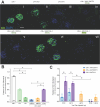This is a preprint.
Truncated Complement Factor H Y402 Gene Therapy Cures C3 Glomerulonephritis
- PMID: 39345485
- PMCID: PMC11429740
- DOI: 10.1101/2024.09.17.613471
Truncated Complement Factor H Y402 Gene Therapy Cures C3 Glomerulonephritis
Update in
-
Truncated complement factor H Y402 gene therapy rescues C3 glomerulonephritis.Mol Ther. 2025 Aug 6;33(8):3746-3756. doi: 10.1016/j.ymthe.2025.04.035. Epub 2025 Apr 24. Mol Ther. 2025. PMID: 40285355
Abstract
Patients with both age-related macular degeneration (AMD) and C3 glomerulonephritis (C3G) are challenged by the absence of effective therapies to reverse and eliminate their disease burden. Capitalizing on complement dysregulation as both a significant risk factor for AMD and the known pathophysiology of C3G, we investigated the potential for adeno-associated virus (AAV) delivery of complement factor H (CFH) to rescue C3G in a Cfh-/- mouse model of C3G. While past efforts to treat C3G using exogenous human CFH resulted in limited success before immune rejection led to a foreign protein response, our findings demonstrate the capacity for long-term AAV-mediated delivery of truncated CFH (tCFH) to restore inhibition of the alternative pathway of complement and ultimately reverse C3G without immune rejection. Comparing results from the administration of several tCFH vectors also revealed significant differences in their relative efficiency and efficacy. These discoveries pave the way for subsequent development of AAV-mediated tCFH replacement therapy for patients with C3G, while simultaneously demonstrating proof of concept for a parallel AAV-mediated tCFH gene augmentation therapy for patients with AMD.
Keywords: C3 glomerulonephritis; C3 glomerulopathy; age-related macular degeneration; complement factor H; complement regulation; gene replacement; gene therapy.
Figures




References
-
- Wong C. W., Wong T. Y., Cheng C. Y. & Sabanayagam C. Kidney and eye diseases: common risk factors, etiological mechanisms, and pathways. Kidney Int 85, 1290–1302 (2014). - PubMed
-
- GBD 2019 Blindness and Vision Impairment Collaborators & Vision Loss Expert Group of the Global Burden of Disease Study. Causes of blindness and vision impairment in 2020 and trends over 30 years, and prevalence of avoidable blindness in relation to VISION 2020: the Right to Sight: an analysis for the Global Burden of Disease Study. Lancet Glob Health 9, e144–e160 (2021).
-
- N C. et al. Causes and prevalence of visual impairment among adults in the United States. Arch Ophthalmol 122, 477–485 (2004). - PubMed
Publication types
Grants and funding
LinkOut - more resources
Full Text Sources
Miscellaneous
